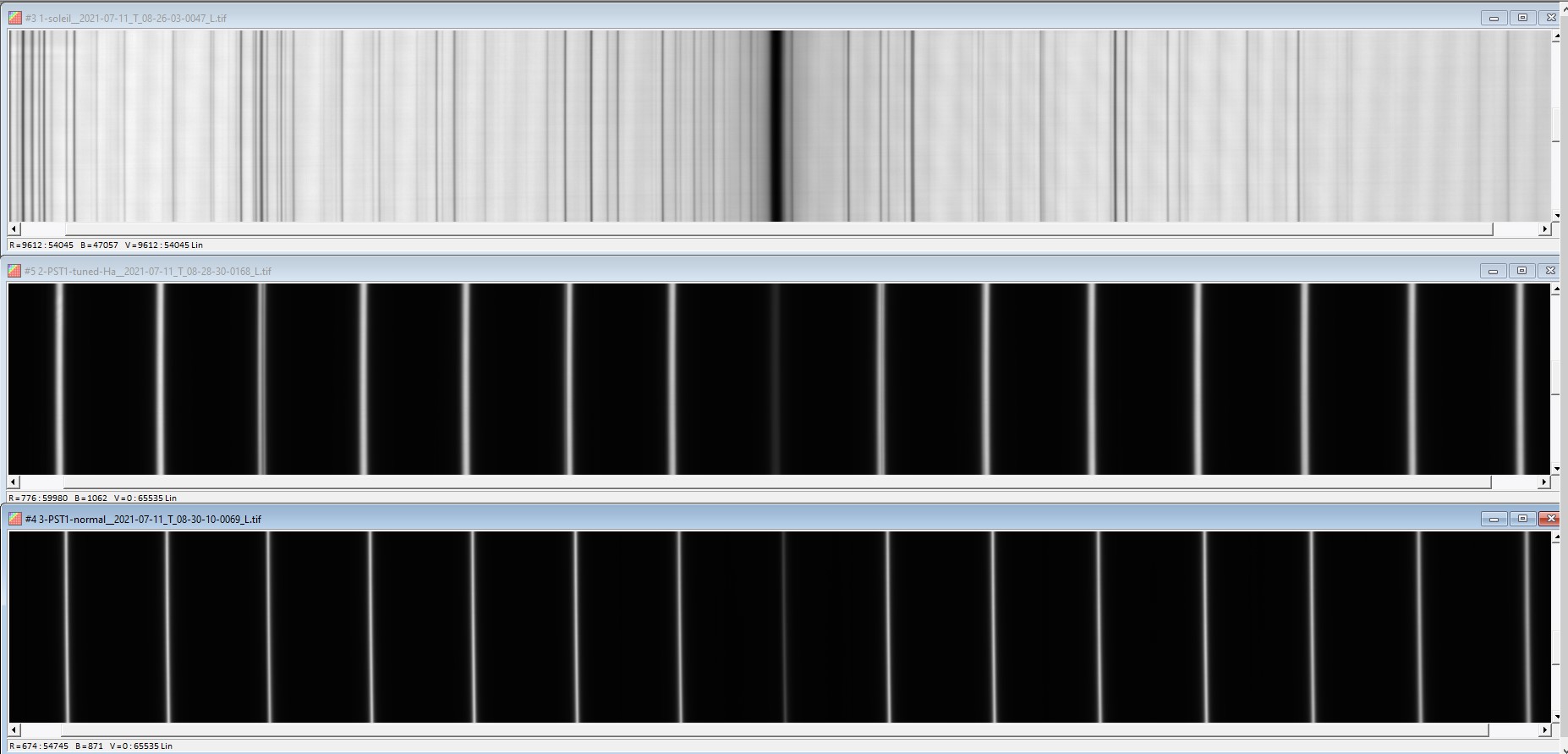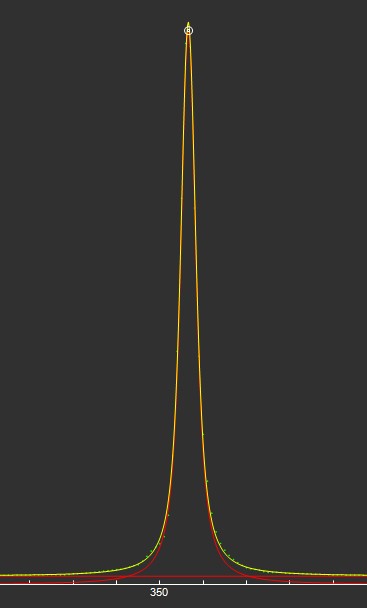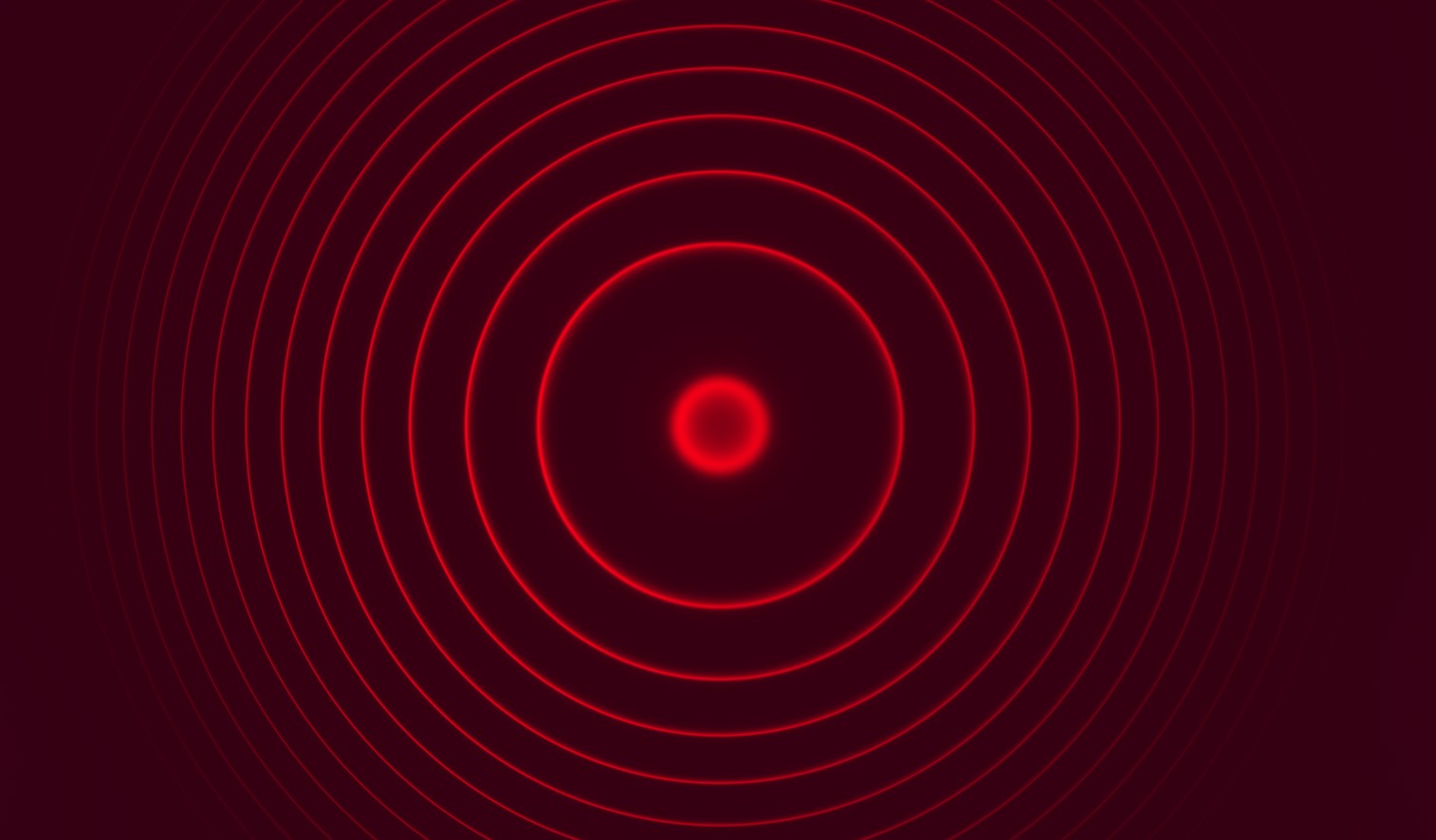This etalon is tested using three different approaches :
(1) - Sol'Ex spectrometer in collimated beam (f/115 beam), etalon at normal incidence (previouly tuned to Ha with knob for f/35 telecentric beam). Measurement done over a 10 micron x 4.5 mm surface, CWL and FWHM non uniformities are not captured.
(2) - Sol'Ex spectrometer with f/27.5 and f/35 telecentric beam, etalon tuned to Ha with its knob for each f-ratio. Measurement done over a 10 micron x 4.5 mm surface, CWL and FWHM non uniformities are not captured.
(3) - interferometry using an Ha lamp, etalon tuned to Ha with its knob for f/35 telecentric beam. The full surface of the etalon is sampled.
The two collimated lenses were removed from the PST assembly. Accordingly, only the etalons are tested.
Other interesting results
- The two PST etalons tested were found to change wavelength by compression (= changing the thickness of the air gap) and not by tilting. This is pretty obvious in the test with the Ha lamp (no change in the fringe system when tilting the etalon, change in CWL only when turning the PST knob). Accordingly, most of the results presented here are for the knob of the etalon tuned to Ha (at f/27.5 or f/35 in telecentric beam).
- For some reasons, in collimated light, the tilt of the etalon induces a strong change in the transmission profile (FWHM and peak transmission of each fringe), while this should not be the case ... Accordingly, these etalon should be used at normal incidence.
(1) - Sol'Ex spectrometer in collimated beam (f/115 beam), etalon at normal incidence (previouly tuned to Ha with knob for f/35 telecentric beam). Measurement done over a 10 micron x 4.5 mm surface, CWL and FWHM non uniformities are not captured.
(2) - Sol'Ex spectrometer with f/27.5 and f/35 telecentric beam, etalon tuned to Ha with its knob for each f-ratio. Measurement done over a 10 micron x 4.5 mm surface, CWL and FWHM non uniformities are not captured.
(3) - interferometry using an Ha lamp, etalon tuned to Ha with its knob for f/35 telecentric beam. The full surface of the etalon is sampled.
The two collimated lenses were removed from the PST assembly. Accordingly, only the etalons are tested.
Other interesting results
- The two PST etalons tested were found to change wavelength by compression (= changing the thickness of the air gap) and not by tilting. This is pretty obvious in the test with the Ha lamp (no change in the fringe system when tilting the etalon, change in CWL only when turning the PST knob). Accordingly, most of the results presented here are for the knob of the etalon tuned to Ha (at f/27.5 or f/35 in telecentric beam).
- For some reasons, in collimated light, the tilt of the etalon induces a strong change in the transmission profile (FWHM and peak transmission of each fringe), while this should not be the case ... Accordingly, these etalon should be used at normal incidence.
Coronado PST n°1
(xx xxx)
1) Sol'Ex spectrometer: measurement in a collimated beam (f/115)
Optical setup: Sun => PST (without any lens) => Sol'Ex
Sol'Ex spectrograph : 10 microns x 4.5 mm slit, 80 mm collimating lens, 125 mm imaging lens, ASI290 camera, 12-bit acquisition.
Measured dispersion = 0.075 A/pixel
11 July 2021 - 8h30
Nota:
- while the etalon was exposed to a collimated beam and the collimating lenses were removed, the spectrum transmitted by the etalon was very sensitive (width and peak of the fringes) to the orientation to the Sun
Three successive images:
- (1) solar spectrum,
- (2) solar spectrum transmitted by the PST etalon with the knob set to Ha for f/35 telecentric beam, the etalon is tilted in order to tune on Ha line at f/115 (near collimated beam).
- (3) solar spectrum transmitted by the PST etalon with the knob set to Ha for f/35 telecentric beam (same as before), the etalon is set at normal incidence (i.e. position with the peak of the fringes the farthest to the red).
- while the etalon was exposed to a collimated beam and the collimating lenses were removed, the spectrum transmitted by the etalon was very sensitive (width and peak of the fringes) to the orientation to the Sun
Three successive images:
- (1) solar spectrum,
- (2) solar spectrum transmitted by the PST etalon with the knob set to Ha for f/35 telecentric beam, the etalon is tilted in order to tune on Ha line at f/115 (near collimated beam).
- (3) solar spectrum transmitted by the PST etalon with the knob set to Ha for f/35 telecentric beam (same as before), the etalon is set at normal incidence (i.e. position with the peak of the fringes the farthest to the red).

FWHM = 0.34 A
FSR = 9.3 A
NB : measurement made on the basis of image (2) gives FWHM = 0.61 A
Coronado PST n°1
(xx xxx)
2.a) Sol'Ex spectrometer: measurement in a telecentric beam (Hat 8 f/27.5)
Optical setup: Sun => Hat 8 => 12 nm Ha Astronomik filter => f/27.5 telecentric => PST (without any lens) => Sol'Ex
Sol'Ex spectrograph : 10 microns x 4.5 mm slit, 80 mm collimating lens, 125 mm imaging lens, ASI290 camera, 12-bit acquisition.
Measured dispersion = 0.075 A/pixel
10 July 2021 - 8h49
The knob of the PST is tuned to center the bandpass on Ha line.

Profile of the
fringes is approximated bya Voigt fonction (convolution of Lorentzian
and Gausian functions) due to the broadening of the FWHM due to the
f/27.5
ratio. Position and FWHM of each fringe are measured directly on the
image
taken with the etalon by fitting a Voigt curve (profile along the X
axis, only one pixel width). There is no need to divide by the solar
spectrum because of the lack of strong solar lines in this part of the
spectrum. Fringe 8 is tuned on Ha with the PST knob.

Results:
FWHM = 0.93 A
FSR = 9.2 A
FWHM = 0.93 A
FSR = 9.2 A
Note : given the 0.34 A FWHM in collimated beam, calculation gives a FWHM of 1.14 A in a f/27.5 telecentric beam, which is relatively consitent with the FWHM of 0.93 A measured here. The difference is probably due to the change of knob setting.
Coronado PST n°1
(xx xxx)
2.b) Sol'Ex spectrometer: measurement in a telecentric beam (Hat 8 f/35)
Optical setup: Sun => Hat 8 => 12 nm Ha Astronomik filter => f/35 telecentric => PST (without any lens) => Sol'Ex
Sol'Ex spectrograph : 10 microns x 4.5 mm slit, 80 mm collimating lens, 125 mm imaging lens, ASI290 camera, 12-bit acquisition.
Measured dispersion = 0.075 A/pixel
10 July 2021 - 9h24
The knob of the PST is tuned to center the bandpass on Ha line (small difference compared to f/27.5)

(xx xxx)
2.b) Sol'Ex spectrometer: measurement in a telecentric beam (Hat 8 f/35)
Optical setup: Sun => Hat 8 => 12 nm Ha Astronomik filter => f/35 telecentric => PST (without any lens) => Sol'Ex
Sol'Ex spectrograph : 10 microns x 4.5 mm slit, 80 mm collimating lens, 125 mm imaging lens, ASI290 camera, 12-bit acquisition.
Measured dispersion = 0.075 A/pixel
10 July 2021 - 9h24
The knob of the PST is tuned to center the bandpass on Ha line (small difference compared to f/27.5)

Results:
FWHM = 0.76 A
FSR = 9.3 A
FWHM = 0.76 A
FSR = 9.3 A
Note : given
the 0.34 A FWHM in collimated beam (with knob setting at f/35), calculation gives a FWHM of 0.75 A
in a f/35 telecentric beam, which is equaivalent to the FWHM of 0.76
A measured.
Coronado PST n°1
(xx xxx)
3) Test with the Ha lamp
Important note:(xx xxx)
3) Test with the Ha lamp
- as expected, tilting the etalon has no impact of the fringe system (diffuse light source),
- however, turning the knob of the PST does impact the CWL, meaning that this PST etalon is tuned by changing the thickness of the gap (same method as RichView sytem).
- for the test, the knob of the PST was tuned to be on Ha with an f/35 telecentric.
PST #1 - Nikon Z6 - 85 mm f/1.8 at f/2 - 100 ISO - 0.77 s exposure - 12 bit acquisition
The non symetry of each fringe proves that the CWL (and the FWHM) is not uniform accross the surface of the etalon. Accordingly, the fringe system was curve fitted with a split-Lorentzian function in order to calculate the FWHM and the peak position of each fringe.
In order to sample a progressively smaller area of the etalon, the fringe system was imaged with the lens set at f/2 (full surface of the etalon sampled), f/4, f/8 and f/10.

NB :
- The FWHM are given for a collimated beam.
- The values of delta CWL are not relevant since they can be adjusted as needed with the rotating knob of the etalon.
The FSR value is the same as found with the spectrometer.
Measured over the full 20 mm surface of the etalon, the average FWHM is equal to 0.54 A. This is the relevant value for a use in a collimated beam, and is quite in line with the PST spec (FWHM < 1 A).
This is much larger than the 0.35 A found with Sol'Ex spectro, the difference being explained by the much smaller surface sampled by the spectro.
For a use in a telecentric beam at f/35 (resp. f/27.5), this 0.61 A FWHM would translate in a 0.91 A (resp. 1.24 A).
Back to narrowband filter testing



